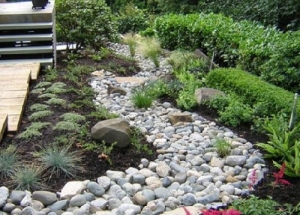Beautiful and unusual looks on the site of the brook, made of stones. Design ideas and technologies allow you to make such an ornament for the garden as close as possible to the natural appearance of the stream - often there is not immediately noticeable the lack of water in such a channel. After the rain, the dry stream revives and transforms, while it is very beautiful to observe the drying stones and the play of light on the glass elements added to the stream.
Content
The tradition of the "dry stream" came to us from the east, where the arrangement of the site with stones is an art that is in no way inferior to the best works of landscape painting. The site, decorated in Japanese and Chinese traditions - what can be more mysterious and unusual?

Decorative dry creek in landscape design is the most simple and optimal option for giving, since it does not require a constant supply of water, and it can be placed anywhere. In the dry season, such an unusual trickle creates an appearance of the current, zonates the space of the site, can serve as a drainage channel and perfectly conceals all irregularities and disadvantages of the relief. A dry stream can be arranged as an imitation of a dried-up bed.
Another option involves creating visibility of the water flow with the help of glass elements (glass beads), natural and decorative stones, pebbles of blue and blue shades.
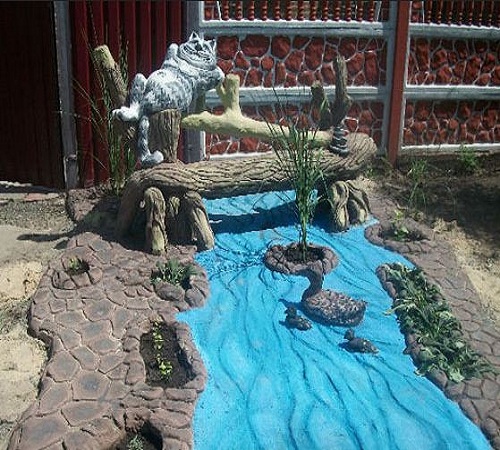
The easiest or most imaginatively pretentious dry stream can always be built independently, it is not difficult to do it technically. Of course, we will have to work hard, but the time, effort and materials for such a construction will be much less than for the arrangement of a real stream. In this article, we will consider in detail the different styles of dry creeks for decorating a homestead, using the most accessible materials and the maximum imagination.
Advantages of a dry brook
It is not necessary to compare a real stream along which water flows, and a decorative "trickle" without water. These are two different types of decoration and decorating a private area. Each of them has its own significant advantages and some disadvantages. Consider the differences in the arrangement of a dry stream, except for the lack of water in it. Naturally, this design idea has a number of advantages, because of which a rocky dry stream becomes more and more popular among land owners.
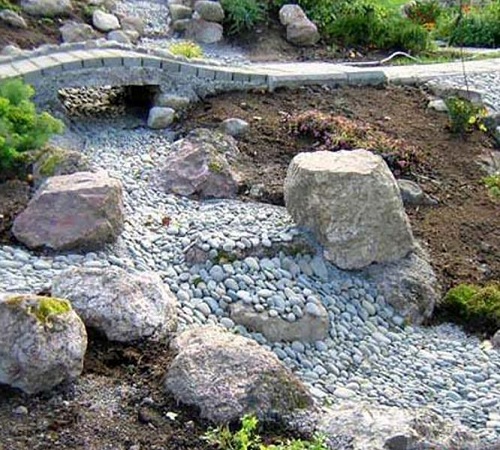
So easy to do yourself
For the arrangement and design of the dry creek zone, it does not take too much time and labor. Such an idea does not require alignment of the site, deepening the channel and lowering the relief for water flow. To create a dry creek with your own hands, you only need the proper planning of the territory and the necessary material (stones, pebbles, bugles) for finishing. If such work is entrusted to specialists, then the arrangement of a dry stream will not be as economically justified as work done independently.
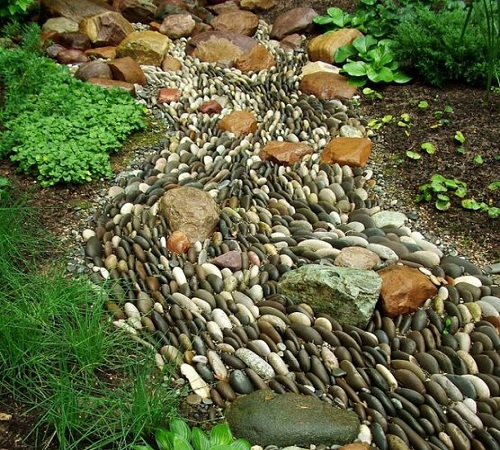
Brook for a couple of days
One or two days will be required for you to choose and place a place under the channel of a dry stream, and then fill it with selected pebbles and additional designer decorations. Another couple of days will be spent on arranging the adjacent territory and planting the plants.
Minimum quantity of materials required
In terms of budget, the dry stream has no equal. It does not require materials and devices necessary for pumping water in a real stream, nor is it necessary to thoroughly pressurize and strengthen the bottom and banks.

Easy maintenance
The choice of plants for decorating a dry stream is not limited to anything - you can plant any plants, and not just hygrophilous ones. Dry creek does not require any special care, except for cleaning from debris and periodic leveling of stones in the bed.
Best tips for beautiful design
Arranging a dry stream at the site is very important to implement a picture that is as close to the natural view. You can try to create a stream where it will seem that the water is only dried up, and the smallest rain will immediately resume the flow. In another case, it is possible to create visibility of flowing water from selected and specially stacked stones. A beautiful highlight will revive the stream in the dark, give the site a mysterious and unusually beautiful view.
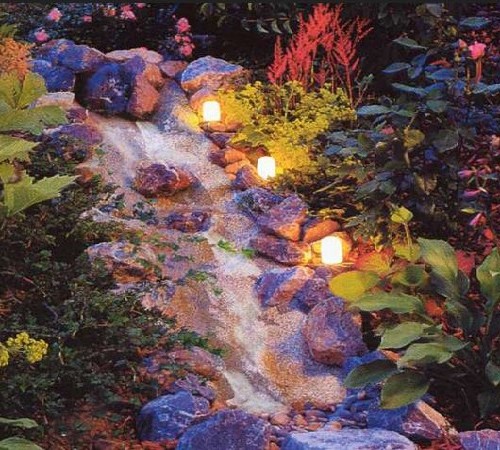
Here are some tips on how to make a dry creek as beautiful and original as possible:
- Dry brooks are executed from a combination of sand, stones, small and large pebbles, shells, or from each of these materials separately. Stones and pebbles can be of any size, shape and color. To achieve greater realism, the stones can be colored in "water" colors.
- All the elements of the dry stream should harmonize with each other, complementing the overall picture. Large stones are usually used to refer to "shores", or the arrangement of stone slides. All decorative ornaments: figurines, vases, lamps, you need to select carefully and dispose not too often, so as not to overdo it and spoil the naturalness of the landscape.

- To give an unusual highlight, the stream "flows" from a hill, or from a certain designated place or object. To equip the "waterfalls" or thresholds, light stones are taken.
- Particularly beautiful and original on the site are streams that merge from several hoses into one, they are executed in the form of winding brooks, running past trees, recreation area and garden paths.
- To make it mysterious and unique, you can make a small "gorge" by the stream. Also very beautiful look bridges and masonry, thrown over a dry riverbed.
- A sinuous narrow dry stream on a small site is able to visually deepen the space and create the appearance of a larger territory.
- If it is planned to equip a recreation area or territory near the house, it is best to simulate a dry pond or a small lake in this place.
Master class on dry creek arrangement
three important stages
At the first stage, it is necessary to plan and prepare the terrain. The "channel" of the future brook must be laid and zadekorirovat so that it really looked like a real one, that is, it is necessary to create the appearance of the flow of water. For better visibility when marking, the easiest way to use light sand (if there is no vegetation on the site). If sand is poured along the contour, then the path of the "current" of the future brook will be very clearly visible. Such a circuit is very easy to adjust and change its trajectory to achieve the necessary parameters.
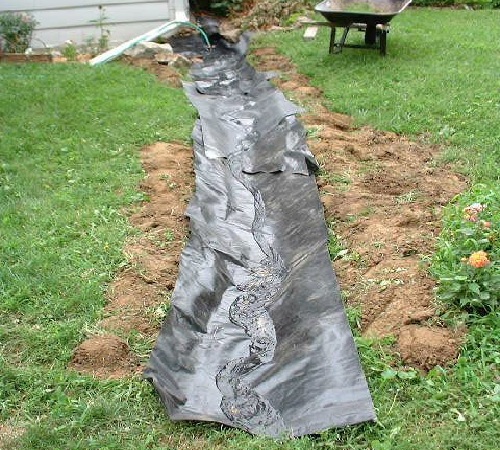
If the site already has vegetation, then in order to equip the place under the creek and its banks, it is necessary to remove turf. For the channel it is necessary to dig a shallow trench (15-25 cm) and lay it with a film. This is necessary so that wild plants and grass do not germinate through the laid stones. However, if planting is planned in the streambed, the film will have to be covered with earth, or cut out the holes for planting directly into the ground.

Attention! If it is planned to organize rainwater runoff on a dry stream, then instead of polyethylene film, geotextiles and geomembrane should be used. They will not allow the laid stones to be washed away by the flow of rainwater.
At the second stage, they are engaged in landscaping of the creek zone. Here fantasy is not limited, it is only necessary to choose the right combination of colors and herbs. Very beautiful look in the gyre of the creek Alpine hills or small bushes. Each of the plants can be planted both in the canal and along the banks, but so that they harmoniously and unobtrusively complement and not obscure the dry trickle itself. For planting in the riverbed, it is best to take perennial plants, - re-planting gardening is quite a troublesome occupation. The earth for flowers is best to take a purchase, it does not have weed seeds. Ideally, you first need to let plants take root, and then completely fall asleep.
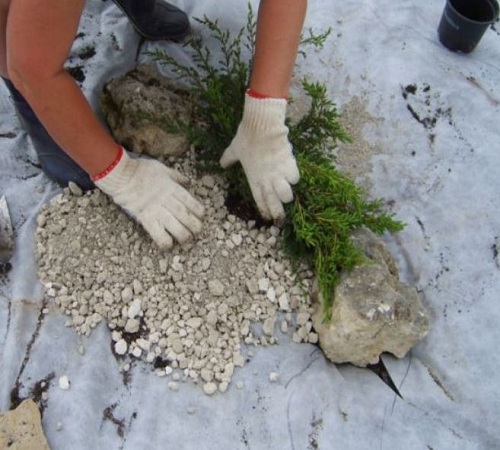
To decorate the banks of the stream, it is still better to choose the moisture-loving plants that are most associated with water and natural water bodies. For example, the bed of a stream can be filled with a large pebble with sand, while the stones are dyed in a delicate blue color. To decorate such a channel, glass balls are laid out. From plants are planted: bamboo leaf-leaf, arundo reed, various types of hosts, irises, bells, lyubelia, mint. This design creates the illusion of a constantly flowing brook.

At the third stage the stream is filled with "stone waters". The simplest and most accessible materials for this are gravel and gravel. As practice shows, such building materials are very beautiful and original look at the reconstruction of the dry stream channel. Stone rocks that are very suitable for imitating a stream include: shale, basalt, gneiss - they look very nice in the channel, as they have shades of gray-blue tones. A special chic stream gives the composition of white marble and limestone, as well as red, brown green shades of granite.
To create the maximum effect of water flow and additional decoration, glass pellets and balls of blue, white and other colors are laid in the channel of a dry stream. The presence of water creates acrylic decorative stones, bugles, which scatter along the creek: it can take up to 5 kg of such material per 1 sq. M of area.
special charm - a floral stream
There is a special facet of landscape design - this is the creation of luxurious and unusual decorations of a site of flowers. That's how the design as a dry stream, you can perform not only from stones.
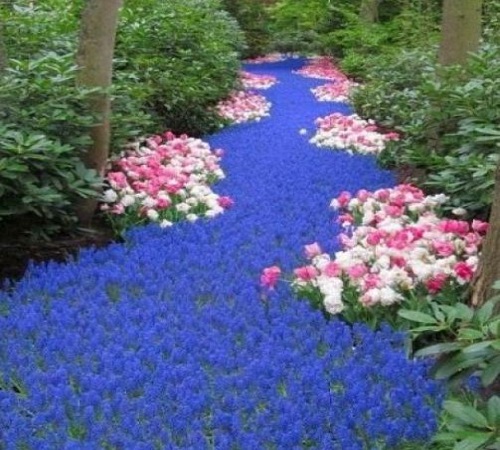
Correctly selected and beautifully planted flowers and herbs create magnificent imitations of streamlets against the background of green grass in the garden.

bridge over a stream
If in the area of the depression, along which a stream flows, are made in the pedestrian zone, that is, the need to install a bridge over a dry channel. At the same time, a dry stream with a bridge, becomes a real decoration of the site, will give it a peculiar zest and naturalness.
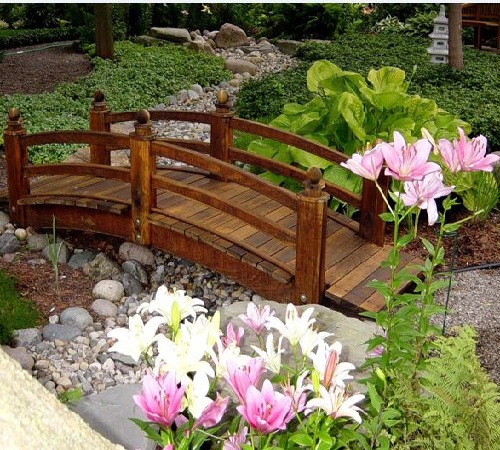
A small decorative bridge or a masonry over a small streamlet can be made independently, but with a large footbridge you will have to tinker. You can buy a ready-made bridge and install it in the right place. The market offers a lot of options for decorative and real bridges for landscape design, from the simplest wooden, to fanciful forged products.
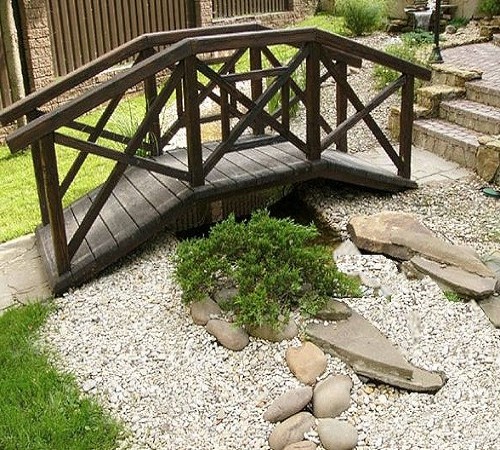
Dry creek care
The procedure for care of the decorative dry creek is to maintain the shape of the channel and care for the planted plants. The "banks" of the stream are periodically exempted from weeds, and not all wild plants need to be destroyed - some wild flowers are very beautiful. Growing shrubs should be cut, and the roots of trees should not be allowed to grow in the direction of the stream.
Large stones sometimes need to be lifted and viewed, ants can be planted under them, which (if they do not fight) will gradually "conquer" an ever larger territory. Moss, formed on stones, also need to be periodically removed, so that it does not heavily crawl on the stones and do not cover them.
By arranging the bed and creating from the plants a beautiful dry creek design, do not forget that flowers, grasses and shrubs need to be watered - this is a dry stream, it does not have water that is so necessary for plants.
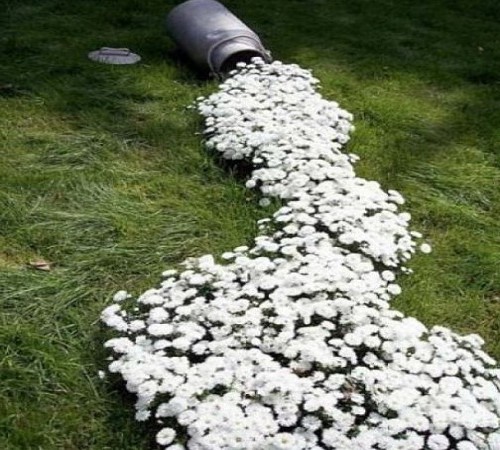
Preparatory work for the winter consists of weeding the riverbed and the banks of the dry basin, removing fallen leaves, branches and debris. If fixtures and other equipment are installed, care must be taken to ensure their safety. Those plants that do not withstand severe colds and are prone to freezing should be covered for winter with heat-insulating material or scooped out.


